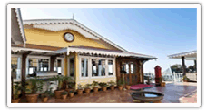About Mahabalipuram
Mahabalipuram, also known as Mamallapuram with its picturesque location on a rocky outcrop between the beach and a lagoon is absolutely a great place to visit. The sea side town is a harmonious combination of history, good beaches, hassle-free tourism and fabulous sea food! Despite being crowded through out the year, the place is friendly, relaxed, and the villagers are remarkably undisturbed by their crowds of visitors. Mahabalipuram is well known for its series of impressive rathas and the spectacularly carved relief depicting Arjuna's Penance. The magnificent Shore Temple, built by king Rajasimha in the 17th century, is a unique temple that shelters the shrines of both Shiva and Vishnu while the Varaha Cave is one of the many rock-cut caves in Mahabalipuram. The city of Mamallapuram or Mahabalipuram, is full of sculpture workshops all around and many artisans thrive on this art here.
HOW TO REACH
By Air : The nearest airport from Mahabalipuram is Chennai (Madras), located around 60 km away. One can get flights for almost all major destinations in India.
By Rail : The nearest railway station, Chengalpattu, is around 29 km away from Mahabalipuram.
By Road : Mahabalipuram or Mamallapuram is connected by road to all the major cities and towns of Tamil Nadu and neighbouring states.
PLACES TO VISIT IN MAHABALIPURAM
• Arjuna's Penance : Arjuna's Penance, a massive relief made on two huge boulders, is a complete universe itself in stone. This colossus of art, 27 m long and 9 m high, is perhaps the world's largest bas-relief. There are some exquisite examples of artistry carved out off stone here, the sight of which should not missed.
• Caves : The Varaha Cave, a small rock-cut mandapam (hall), is a faceted and finished gem with two incarnations of Vishnu-Varaha (boar) and Vamana (dwarf). Particularly remarkable are four panels of the famous Pallava doorkeepers. The Dharmaraja Cave, built in the early 17th century, contains three empty shrines. The Mahisasurmardini Cave (mid-17th century) has exemplary bas-reliefs on its panels of everlasting beauty. The Somaskanda sculpture emits peace, power, and wisdom while Lord Vishnu is shown in omniscient repose in a masterpiece of dhwani (the art of suggestion). On the opposite side is a huge theatrical panel showing, Goddess Durga's fight with the demon Mahishasura, an episode culled from the celebrated Sanskrit poem Devi Mahatmya.
• Rathas (Chariots) : A group of beautiful structures scattered at the southern extreme of Mahabalipuram, amidst casuarina trees, are the well known Rathas (chariots). Known as the Pancha Pandava Rathas, they are five in number. Out of these, four are carved out of a single rock, while the fifth one on the west is chiseled out from a small rock. The square Draupadi and Arjuna Rathas, the linear Bhima Ratha, the taller Dharamraja Ratha and the apsidal Nakula-Sahadeva Ratha, completes the complex.
• Krishna Mandapam : The amazingly carved stone temple is one of the earliest rock-cut temples of Mahabalipuram. The walls of the temples displays picture of pastoral life, one with the image of Krishna lifting the Govardhan Hill in his fingertips to protect his people from Indra.
• Shore Temple : The windswept and surf-beaten Shore Temple evokes the aura of Mahabalipuram. A three-in-one abode of god - a Vishnu temple confined between two Shiva temples, the Shore Temple is a visual delight. The surroundings of the temple abound in architectural masterpieces.
• Covelong : The Crocodile bank is located nearly 14 km away from Mahabalipuram on the Chennai-Mahabalipuram road. The bank is a perfect place to view large variety of crocodiles. Located nearby is a snake farm where anti-venom is produced for treating snakebites.
|







